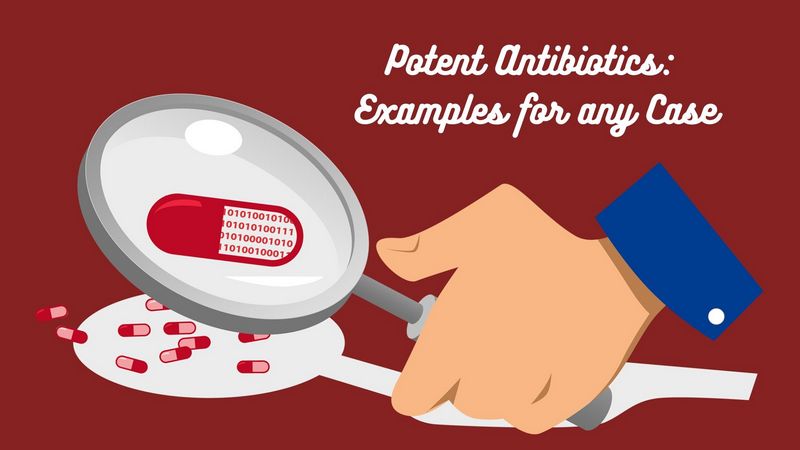Potent Antibiotics: Examples for any Case
Nowadays commonly used antibiotics are cephalosporin, macrolides, fluoroquinolones, imipenem, penicillin group. The most powerful antibiotics – broad-spectrum antibiotics, providing a detrimental effect on gram-positive and gram-negative bacteria.
Below, Mercury Free Drugs review the main group of the most potent antibiotics.
List of Some Potent Antibiotics
Cephalosporin
This is the most powerful antibiotics of broad-spectrum having a bactericidal effect. They are well tolerated, it happens due to the low probability of undesirable effects occurrence. This group includes 4 generations:
Cephalosporins 1st generation:
- Cefazolin (Rizolin, Cezolin, Kefzol);
- Cephalexin (Sporidex, Ceff, Ospexin);
- Cefadroxil (Biodroxil).
Preparations 1 generation is active against staphylococci.
Cephalosporins 2nd generation:
- Cefaclor (Vercef, Taracef);
- Cefamandole (Cefat);
- Cefuroxime (Axetin, Ketocef, Zinnat).
Drugs is sensitive against Klebsiella, Proteus, Haemophilus influenzae, Escherichia coli.
Cephalosporins 3rd generations:
- Cefotaxime (Claforan, Cefosin);
- Cefoperazonum (Medocef, Cefobid);
- Ceftazidimum (Fortum, Fotrazim);
- Ceftibutenum (Cedax);
- Ceftriaxonum (Lendacin, Sorcef).
This generation is often used for treatment in hospitals such diseases as:
- pneumonia;
- pyelonephritis;
- abdominal;
- pelvic infections;
- osteomyelitis;
- meningitis.
Cephalosporins 4th generation – the most powerful antibiotic: The most widespread is Cefepime (Maxipime)
This medication has a more broad spectrum of action in comparison with 3 generations.
In the 4th generation more serious side effects: nephrotoxicity, haematotoxicity, neurotoxicity, dysbacteriosis.
Macrolides
Macrolides antibiotics are of narrow application, effective against gram-positive bacteria. They render bacteriostatic action, i.e. stop the growth of bacterial cells. Do not depress the immune system.
Representatives of this group – erythromycin, oleandomycin, azithromycin, clarithromycin, josamycin, spiramycin, roxithromycin. Clarithromycin and josamycin are the most strong antibiotics from macrolide group. They are used to treat respiratory tract infections, otitis media, sinusitis, chlamydial infections in dentistry, for gastric ulcer radiation.
Side effects of macrolides are:
- quickly reduced sensitivity;
- allergy;
- indigestion;
- phlebitis at injections.
Fluoroquinolones
Fluoroquinolones – the most strong antibiotics of broad action spectrum. Fluoroquinolones are divided into early (1st generation) – exhibiting significant activity with respect to gram-positive bacteria, pseudomonas aeruginosa. “New” fluoroquinolones (2nd generation) against Gram bacteria are not inferior to 1 generation (except Pseudomonas aeruginosa, the most powerful antibiotic against Pseudomonas aeruginosa – Ciprofloxacin). It for long circulates in the blood, allowing you to use drugs of the first Generation 2 times during the day, and Lomefloxacin and Moxifloxacin – once a day. It perfectly penetrates individual organs and tissues.
Some representatives of this group are:
- Ciprofloxacin (Ciprobay, Ciprolet, Cifran). They are applied in case of respiratory infections, urinary tract infections, skin, soft tissues infections, bones suppuration, joints, STDs, sepsis, meningitis;
- Lomefloxacin (Lomflox, Maxaquin) – is used: general indications + chlamydia, tuberculosis;
- Norfloxacin (Nolicin, Norbactin, Normax) – urinary infections;
- Ofloxacin (Zanocin, Ofloxin, Tarivid). Assign: general indications + chlamydia, Helicobacter pylori, Gardnerella;
- Pefloxacin (Abaktal, Perti);
- Sparfloxacin (Sparflo);
- Levofloxacin (Tavanic);
- Moxifloxacin (Avelox).
The most common side effects are:
- phototoxicity;
- dyspepsia;
- liver toxicity.
Carbapenems
Carbapenem – also the strongest antibiotics, possessing a broad spectrum of action. They are used as a backup means with infections caused by resistant enterobacteria and anaerobes.
Some representatives are:
- Tienam (Imipenem+ Cilastatinum);
- Meropenem (Meronem).
The most common side effects are:
- phlebitis;
- candida;
- allergies;
- indigestion.
Penicillin
Penicillin – the most powerful antibiotics of a broad spectrum. They are Low-toxic, excreted mainly by kidneys.
These are some representatives of this group:
- Benzylpenicillinum (sodium salt, potassium salt, novocaine salt);
- Long-acting penicillins (penicillin procaine, Bicillin 1, 3, 5);
- Phenoxymethylpenicillin;
- Ampicillin;
- Oxacillinum;
- Ampiox;
- Amoxicillin (Flemoxin Solutab, Hiconcil);
- Amoxicillin-clavulanate (Amoksiklav, Augmentin, Moxiclav, Klavocin);
- Ampicillin + sulbactam.
Antibiotics of penicillin group are used for infections of a respiratory system, urinary tract, stomach and intestines, skin, soft tissue suppuration, syphilis, gonorrhea treatment. Protected penicillins have a broader spectrum of activity. Penicillin can be prescribed since birth. They can be taken by pregnant women during the 2nd and 3 trimesters, as well as during lactating period.
Common side effects are diarrheal disorders, allergies, toxic effects on the blood.


